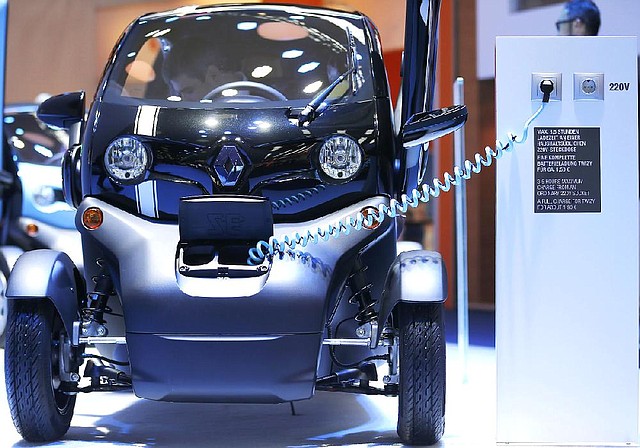Europe’s carmakers following different paths into the future
The Renault Twizy electric car is displayed Wednesday at the Frankfurt Auto Show in Frankfurt, Germany.
Thursday, September 12, 2013
FRANKFURT, Germany - In the face of the slowest European car sales in two decades, competitors such as Opel, Renault, Ford and Peugeot are introducing new models or at least flaunting design studies at the Frankfurt Auto Show.
But Fiat has no big news this week. And that was by design, the company’s executives said.
“To launch a new model now, you lose a good opportunity, because when the market recovers, the model will be old,” said Luca di Montezemolo, the chairman of the Ferrari unit of Fiat and a member of the Fiat board.
Other carmakers are taking the opposite tack to deal with an industry crisis. “There is no other way to compete in a tight market except with new products,” said Karl-Thomas Neumann, president of General Motors Europe and chief executive of the company’s Opel unit.
The fates of companies and thousands of jobs will depend on which strategy turns out to be right. If the market has hit bottom and begins to grow again, as some in the industry predict, Opel’s decision to offer a face-lift of its flagship Insignia, a sibling of the Buick Regal, will look smart. But if sales fail to improve, the Insignia and other new models may sell only at heavy discounts, adding further to the billions of dollars in losses that Opel has accumulated in Europe. The same risk threatens the other mass-market carmakers that have suffered the most since European sales began to plummet in 2008, including Ford, Renault and PSA Peugeot Citroen.
Because Fiat owns Chrysler, and its chief executive, Sergio Marchionne, is chief executive of both companies, the Italian carmaker’s fate has implications for its U.S. sibling. Marchionne, normally a dominant presence at car shows because of his bluntness and sarcasm, caused a stir when he canceled a news conference planned for Tuesday. A spokesman for Fiat said that Marchionne was too busy and that his low profile did not signal “anything sinister.”
Because of the enormous complexity of designing and making a car, including marshaling a large supplier network, decisions on when to introduce and produce new cars are made at least two years in advance. Auto executives who are unveiling cars now are reckoning with decisions they, or in some cases their predecessors, made long ago.
Still, in the here and now, there is a strong correlation between how the auto companies are assessing the near-term market and the availability of new models.Di Montezemolo of Ferrari voiced pessimism about the mass market. “Europe is still very difficult,” he said. “I don’t see any kind of recovery.”
Stephen Odell, chief executive of Ford of Europe, however, said he expected the European market to grow 20 percent in the next five years. “There are plenty of indicators we are running around what looks like the bottom,” he said.
If so, Ford is ready to throw cars at the rebound. The company said it would introduce 25 new models by the end of 2017. That was a substantial increase from a year ago, when the company said it would introduce 15 new models through 2017.
At the show this week, Ford unveiled a high-end version of its flagship Mondeo, called the Vignale, as well as a design study for a new version of its S-Max minivan.
Carlos Ghosn, chief executive of the Renault-Nissan Alliance, was also fairly optimistic. “I think we are about to see the end of the five-year decline,” he said at a news conference.
Ghosn noted that sales of used cars had improved, which he said was a sign that new-car sales would follow.
“We have seen the volume of used cars go up, and we’ve seen prices firm up,” Ghosn said. “We are pretty confident that the slope is ending.” But it is unlikely to be a strong recovery, he said.
Business, Pages 23 on 09/12/2013
